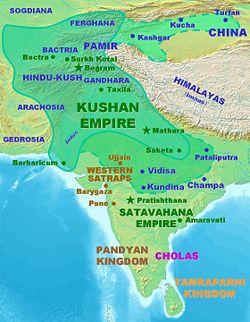कुषाण राजवंश
यह लेख किसी और भाषा में लिखे लेख का खराब अनुवाद है। यह किसी ऐसे व्यक्ति द्वारा लिखा गया है जिसे हिन्दी अथवा स्रोत भाषा की सीमित जानकारी है। कृपया इस अनुवाद को सुधारें। मूल लेख "अन्य भाषाओं की सूची" में "{{{1}}}" में पाया जा सकता है। |
इस लेख का शीर्ष भाग इसकी सामग्री का विस्तृत ब्यौरा नहीं देता। कृपया शीर्ष को बढ़ाएँ ताकि लेख के मुख्य बिंदुओं को एक झलक में पढ़ा जा सके। |
कुषाण प्राचीन भारत के राजवंशों में से एक था। कुछ इतिहासकार इस वंश को चीन से आए युएझ़ी लोगों के मूल का मानते हैं। इसी वजह से सम्राट कनिष्क ने अपना नाम और राजकीय भाषा भी बैक्ट्रीयन आर्य भाषा कर ली: यहां एक मजबूत प्रमाण और मिल जाता है कि वो कषाणा समुदाय में सम्मिलित हुए और इस तरह पूरी तरह आर्य संस्कृति में कुषाण अपने आप को आत्मसात करके आर्य्यावर्त्त में शाशन करने लगे।
सर्वाधिक प्रमाणिकता के आधार पर कुषाण वन्श को पश्चिम् चीन से आया हुआ माना गया है। लगभग दूसरी शताब्दी ईपू के मध्य में सीमांत चीन में युएझ़ी नामक कबीलों की एक जाति हुआ करती थी जो कि खानाबदोशों की तरह जीवन व्यतीत किया करती थी। इसका सामना ह्युगनु कबीलों से हुआ जिसने इन्हें इनके क्षेत्र से खदेड़ दिया। ह्युगनु के राजा ने ह्यूची के राजा की हत्या कर दी। ह्यूची राजा की रानी के नेतृत्व में ह्यूची वहां से ये पश्चिम दिशा में नयी जगह की तलाश में चले। रास्ते में ईली नदी के तट पर इनका सामना व्ह्सुन नामक कबीलों से हुआ। व्ह्सुन इनके भारी संख्या के सामने टिक न सके और परास्त हुए। ह्यूची ने उनके उपर अपना अधिकार कर लिया। यहां से ह्यूची दो भागों में बंट गये, ह्यूची का जो भाग यहां रुक गया वो लघु ह्यूची कहलाया और जो भाग यहां से और पश्चिम दिशा में बढा वो महान ह्यूची कहलाया। महान ह्यूची का सामना शकों से भी हुआ। शकों को इन्होंने परास्त कर दिया और वे नये निवासों की तलाश में उत्तर के दर्रों से भारत आ गये। ह्यूची पश्चिम दिशा में चलते हुए अकसास नदी की घाटी में पहुँचे और वहां के शान्तिप्रिय निवासिओं पर अपना अधिकार कर लिया। सम्भवतः इनका अधिकार बैक्ट्रिया पर भी रहा होगा। इस क्ष्रेत्र में वे लगभग १० वर्ष ईपू तक शान्ति से रहे।
चीनी लेखक फान-ये ने लिखा है कि यहां पर महान ह्यूची ५ हिस्सों में विभक्त हो गये - स्यूमी, कुई-शुआंग, सुआग्म, ,। बाद में कुई-शुआंग ने क्यु-तिसी-क्यो के नेतृत्व में अन्य चार भागों पर विजय पा लिया और क्यु-तिसी-क्यो को राजा बना दिया गया। क्यु-तिसी-क्यो ने करीब ८० साल तक शासन किया। उसके बाद उसके पुत्र येन-काओ-ट्चेन ने शासन सम्भाला। उसने भारतीय प्रान्त तक्षशिला पर विजय प्राप्त किया। चीनी साहित्य में ऐसा विवरण मिलता है कि, येन-काओ-ट्चेन ने ह्येन-चाओ (चीनी भाषा में जिसका अभिप्राय है - बड़ी नदी के किनारे का प्रदेश जो सम्भवतः तक्षशिला ही रहा होगा)। यहां से कुई-शुआंग की क्षमता बहुत बढ़ गयी और कालान्तर में उन्हें कुषाण/कुस या खस कहा गया।
सन्दर्भ
- ↑ "The Rabatak inscription claims that in the year 1 Kanishka I's authority was proclaimed in India, in all the satrapies and in different cities like Koonadeano (Kundina), Ozeno (Ujjain), Kozambo (Kausambi), Zagedo (Saketa), Palabotro (Pataliputra) and Ziri-Tambo (Janjgir-Champa). These cities lay to the east and south of Mathura, up to which locality Wima had already carried his victorious arm. Therefore they must have been captured or subdued by Kanishka I himself." "Ancient Indian Inscriptions", S. R. Goyal, p. 93. See also the analysis of Sims-Williams and J.Cribb, who had a central role in the decipherment: "A new Bactrian inscription of Kanishka the Great", in "Silk Road Art and Archaeology" No4, 1995–1996. Also Mukherjee B.N. "The Great Kushanan Testament", Indian Museum Bulletin.
- ↑ The Kushans at first retained the Greek language for administrative purposes but soon began to use Bactrian. The Bactrian Rabatak inscription (discovered in 1993 and deciphered in 2000) records that the Kushan king Kanishka the Great (c. 127 AD), discarded Greek (Ionian) as the language of administration and adopted Bactrian ("Arya language"), from Falk (2001): "The yuga of Sphujiddhvaja and the era of the Kuṣâṇas." Harry Falk. Silk Road Art and Archaeology VII, p. 133.
- ↑ The Bactrian Rabatak inscription (discovered in 1993 and deciphered in 2000) records that the Kushan king Kanishka the Great (c. 127 AD), discarded Greek (Ionian) as the language of administration and adopted Bactrian ("Arya language"), from Falk (2001): "The yuga of Sphujiddhvaja and the era of the Kuṣâṇas." Harry Falk. Silk Road Art and Archaeology VII, p. 133.
- ↑ André Wink, Al-Hind, the Making of the Indo-Islamic World: The Slavic Kings and the Islamic conquest, 11th-13th centuries, (Oxford University Press, 1997), 57.
- ↑ The Silk Road in World History By Xinru Liu, Pg.61 [१] स्क्रिप्ट त्रुटि: "webarchive" ऐसा कोई मॉड्यूल नहीं है।
- ↑ साँचा:cite web
